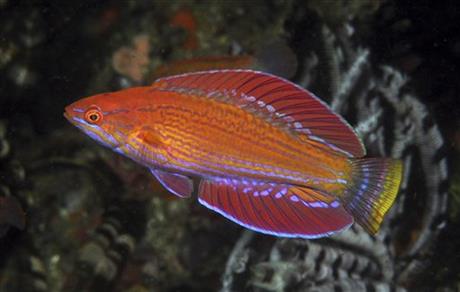
This photo taken on July 28, 2013, released by the Conservation International, shows a new fish of the flasher wrasse species, in Indonesia. A new fish of the flasher wrasse species with striking orange color and rounded fins has been found in Indonesia’s coral reefs, a conservation group announced Wednesday, Nov. 13, 2013. Scientists from the Conservation International and the Indonesian Biodiversity Research Centre discovered the species in East Nusa Tenggara province, said a release from the Conservation International. (AP Photo/Conservation International, Gerald Allen)
JAKARTA, Indonesia (AP) — A new fish of the flasher wrasse species with striking orange color and rounded fins has been found in Indonesia’s coral reefs, a conservation group announced Wednesday.
Scientists from Conservation International and the Indonesian Biodiversity Research Centre discovered the species in East Nusa Tenggara province, said a statement from Conservation International.
The discovery was published in the latest Aqua, International Journal of Ichthyology.
The group said the species was named Paracheilinus rennyae in recognition of the scientific contributions of ichthyologist Renny Kurnia Hadiaty from the Indonesian Institute of Sciences.
The fish is known only from reefs off southwestern Flores Island and the Komodo National Park area. Although it is the 17th known type of flasher wrasse, it is unique in both its coloration and especially the rounded shape of its dorsal and anal fins and tail, and genetically distinct from all other known flasher wrasses in the Coral Triangle, Conservation International said.
Flasher wrasses are favorites among divers and underwater photographers due to their electric blue and red color patterns, which are only displayed as part of a daily mating ritual that normally occurs about an hour before sundown.
At that time, the normally brownish-colored males rise up in the water column and “flash” their spectacular mating coloration while erecting their fins and swimming in short bursts of speed in an attempt to impress nearby female flasher wrasses and encourage them to spawn.
Komodo National Park, encompassing a number of islands and their surrounding waters, is popular with divers, and it’s hoped that such discoveries will increase the tourism value of the park.
The Indonesian Biodiversity Research Centre is a collaborative initiative of some Indonesian universities, the University of California Los Angeles and Conservation International Indonesia.



